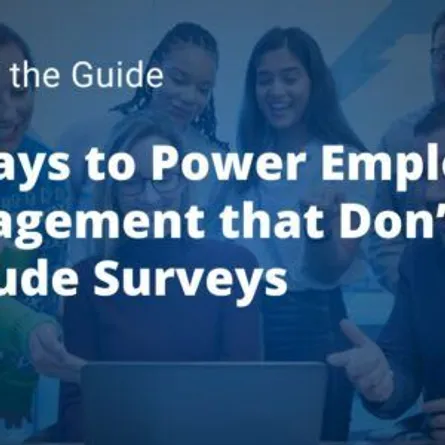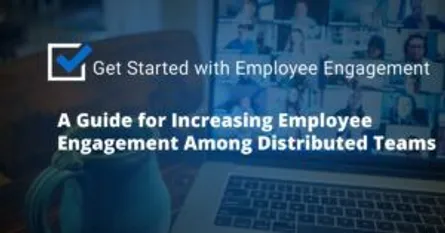
Employee engagement

3 Ways to Power Employee Engagement Beyond the Survey
- 05 Aug, 2024
- Employee Engagement
So you've rolled out your employee engagement survey and find yourself with some interesting insights! Now what? If you’re not sure what to do with that data, you’re not alone. Most companies don't know how to operationalize these insights to truly improve performance and the employee experience. But there’s not a moment to spare right now. In a trend that kicked off in 2021, more than 47 million people quit their jobs last year, and a record-breaking 4.5 million Americans quit in March alone (BLS), amounting to 3.0% of the workforce. Without a strategy for putting your employee engagement survey insights to work and a roadmap for operationalizing your culture , you may keep losing employees. The Problem with Employee Engagement Surveys Originally a human resources concept, employee engagement has taken on broader context and value in the modern workplace, serving as a measure of employees’ dedication and enthusiasm for their job, managers, co-workers, and the organization. However, HR departments often find it difficult to get employees to complete these employee engagement surveys. Sometimes, when workers do fill them out and HR discovers a department has a morale problem, it can be just as difficult to get those workers to speak up and explain why they're unhappy. There’s good reason for that. Employee engagement surveys, and the way they're administered, tend to have flaws that either prevent leaders from truly understanding morale at their companies, or from doing much to lift morale if it's low. Many surveys ask information about the respondent’s department, general title, compensation level, years with the company, and so on – making anonymity unlikely. Often, employees suspect that managers will easily figure out which replies were from whom, casting doubt on how honest a respondent might be. So if a survey reveals widespread discontent in a department or across the company, whether a leader will be able to address employee concerns will depend on how candid workers feel they can be with that leader. Surveys tend to serve as a poor substitute for daily face-to-face communication. The idea should be to create enough trust such that people can speak up without having to hide behind surveys. Your employee engagement survey will only be as successful as the effort and ability for post-survey culture change. When leaders do learn of morale problems through surveys, their reactions can range from denial and defensiveness to an embracing attitude that looks at the results as a baseline measure upon which improvements can be made. Better Ways to Foster a Culture of Feedback and Stronger Employee Engagement Use Shorter, Ongoing Feedback Channels: Use surveys to learn about your employees’ feelings on engagement. Let’s take a brief look at a couple of survey options:Pulse Survey Feedback: Organizations can frequently perform pulse surveys, which consist of 10-15 questions on a specific topic. These quick surveys don’t take much of your employees’ productivity time, but they give you a real-time reading of the mood throughout your organization. Career Mobility and Development Feedback: These types of surveys are typically peer-to-peer and subordinate-to-employee. They can help make the annual review process easier and more streamlined, but also provide valuable information on your employees’ career mobility plans. Employees now expect mobility and flexibility to move into different roles and to shape their workdays. But many employers do not create personalized progression plans for their employees.Conduct One-to-One Employee Interviews: Employee engagement interviews can be informal exchanges among managers or HR leaders and remote employees through phone calls or Zoom sessions. These might be helpful to conduct each month or quarter. They are an opportunity for employees to share any concerns, new ideas, comments, and for you to demonstrate that you hear and see the employee. These face-to-face check-ins can also help you nip problems in the bud – before they grow into mountains and this becomes an exit interview. Encourage Virtual Break: Employees naturally form relationships at the watercooler or taking 15-minute walks together. In today’s way of working, encourage your employees to make these breaks virtual. Recommend setting up a Zoom coffee break or a Zoom walk via social media posts. Thanks to smartphones, people can enjoy break time with co-workers just as easily and regularly as ever, which will help build trust and stronger relationships – translating into better engagement. Run Mood Meter Checks: Before the beginning of a meeting, ask everyone to respond with a quick phrase, single term, emoji, gif or meme to reflect a combination of their mood and personality – or ask for a rating between 1 to 10. These fun mood checks are low-key surveys without the intention of gathering feedback. Instead, these mood checks can be used to make sure everyone is having a good day and to see if you need to follow up with anyone after the meeting. Mix It Up With Games Thanks to today’s amazing technological tools, you can create a seamless work environment for everyone, no matter where they are. Suggest that employees participate in fun activities such as:Open mic sessions for singers, poets and comedians Scavenger hunts Gardening chats and seed-starting tutorials Interactive video games Team triviaReal-Time Communication & Collaboration Tools for Better Connection: One of the biggest sources of employee frustration and discontent is a lack of connection and ability to collaborate effectively with teammates. With a communication & collaboration plugin to your already existing daily communication tools – Gmail, Outlook, Zoom, Teams, and Slack, you have access in real time to:Tips to better understand team members’ learning styles, motivations, and values An ability to create a more equitable and engaging experience for remote team members Actionable emotional intelligence data that helps team members work better with one anotherThe Next Step: Operationalizing Engagement In addition to these tactics, consider what technology can do for you when it comes to putting your employee engagement survey insights to work. This means taking the challenges you uncovered during your employee engagement survey and identifying WHY employees feel this way and HOW to improve it. What are the behavior, motivators, and work energizers that have led to your survey results -- the why? Knowing if your team members are content or not, engaged or not, is not all that helpful. And it also does not help align your culture to business strategy, which is essential if you want to improve organizational performance. That's where Humantelligence comes in. We help you understand the why and then provide the insights needed to align culture to strategy for a team, a functional group, a division, or the entire organization. In the end, team members who are engaged and connected with their organization tend to feel that their position and efforts in the company make a difference. This feeling can inspire them to stay with the organization longer. They also want to work in a role that matches their values and builds their skills. The problem is, many employees are not in roles that match their skills or their values. Compounding that, employers are using a “warm body” approach to hiring, not considering the personality traits, motivations or skills of candidates. Because of that, employee frustration often comes through in the employee engagement survey results. Make sure employees are a fit for their role and that it aligns with their goals. As a result, your team's performance and productivity will improve.

A Guide to Increasing Employee Engagement Among Distributed Teams
- 25 Oct, 2023
- Employee Engagement
A fast employee churn rate can lead to higher training costs, low employee morale, and operational inefficiencies. Eventually, it can reduce your profits and negatively impact your bottom line. That’s why it’s important for businesses to learn how to prepare for it but, better yet, actually focus on slowing it by increasing employee engagement. Last year, Gallup reported that while the number of engaged workers held steady at 32% the number of actively disengaged employees rose to 18%. This is not good news when you consider that a disengaged employee is 2.3x more likely to be exploring other jobs! Employee engagement is a measure of employees’ commitment to helping their organization achieve its goals. It’s demonstrated by how employees think, feel, and act, as well as the emotional connection employees feel towards their organization, their work, and their teams. Before the pandemic, engagement and well-being were rising globally for nearly a decade -- but now, they're stagnant, and most believe it’s because they don't find their work meaningful. Now is no time to take our eyes off the road when it comes to employees’ personal and professional well-being. Addressing the structural and cultural issues that create disengagement in your organization is the first step to laying the foundation for a new and better employee experience. Top Reasons for Employee Disengagement & Turnover Now more than ever, organizations are actively discussing the importance of employee engagement, but not everyone agrees on how to define and measure it. For our purposes, let’s define it as a state and behavior in which employees are enthralled by their work and devote their hearts and minds to it. Engagement like this requires true connection– connection to others, the team, and business goals. Engagement like this is founded on an organization’s and team member’s trust, integrity, two-way commitment, and communication. Here’s Why Increasing Employee Engagement Matters Employee engagement helps businesses succeed by improving organizational and individual performance, productivity, and well being. With the right employee engagement software, strategy, and leadership buy-in, an employee engagement strategy is:Quantifiable; Can be cultivated and substantially increased; and conversely, Can be squandered and discarded.It’s no secret that companies with engaged workforces vastly outperform those without them. When people feel their work matters and that they’re valued, the sky is the limit. Employee engagement has a very real impact on organizational success. Companies with highly engaged workforces are 24% more profitable. (Gallup) Disengaged employees cost organizations an estimated $450-550 billion each year. (The Engagement Institute) 80% of employees said learning and development opportunities would help them feel more engaged on the job. (Udemy) Engaged employees are 44% more productive than workers who merely feel satisfied. (Bain & Company)The Best Ways to Increase Employee Engagement Employees can only perform at a high level when they’re set up for success, with the right tools, processes, and guardrails in place for optimal productivity. Creating an engaging, motivating, and supportive employee experience increases productivity and leads employees to being:15x more likely to recommend the company to friends and colleagues. 1.5x more willing to learn new skills and responsibilities. Almost 6x more likely to plan on staying for a full career.The good news…your employee engagement ideas don’t have to break the bank. They just need to be deliberate, thoughtful and work in unison. With these five keys, you’ll be well on your way to building a stronger internal brand, energizing employees, and promoting employee advocacy.Enable Mentorship, Learning & Initiatives Actively Combat Burnout Recognize Employee Contributions Big or Small Make Time to Connect & Communicate Use Technology to Create a Work Environment Based on Connection & TrustAt the end of the day, employee engagement involves a person’s perception, feelings, and beliefs about the business, the people they work with, leadership, and the work itself. The drivers of employee engagement are highly personal, dependent on the company culture, and while they vary for each individual, these employee engagement ideas have proven to boost retention and coax the disengaged back into the game. Ensuring a positive and empowering working environment where all employees feel valued and connected doesn’t just help your company; it helps your people. An employee who feels connection to others is an employee who is more likely to find their work meaningful. An employee who finds their work meaningful is an employee likely to be engaged – demonstrating through their work a commitment to the overall success of the business.